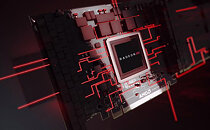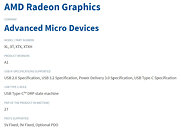Monday, January 4th 2021

AMD Radeon Navi 21 XTXH Variant Spotted, Another Flagship Graphics Card Incoming?
AMD has recently launched its Radeon "Big Navi" 6000 series of graphics cards, making entry to the high-end market and positioning itself well against the competition. The "Big Navi" graphics cards are based on Navi 21 XL (Radeon RX 6800), Navi 21 XT (Radeon RX 6800 XT), and Navi 21 XTX (Radeon RX 6900 XT) GPU revision, each of which features a different number of Shaders/TMUs/ROPs. The highest-end Navi 21 XTX is the highest performance revision featuring 80 Compute Units with 5120 cores. However, it seems like AMD is preparing another similar silicon called Navi 21 XTXH. Currently, it is unknown what the additional "H" means. It could indicate an upgraded version with more CUs, or perhaps a bit cut down configuration. It is unclear where such a GPU would fit in the lineup or is it just an engineering sample that is never making it to the market. It could represent a potential response from AMD to NVIDIA's upcoming GeForce RTX 3080 Ti graphics card, however, that is just speculation. Other options suggest that such a GPU would be a part of mainstream notebook lineup, just like Renoir comes in the "H" variant. We have to wait and see what AMD does to find out more.
Sources:
USB, via VideoCardz


40 Comments on AMD Radeon Navi 21 XTXH Variant Spotted, Another Flagship Graphics Card Incoming?
Perhaps because 6800 XTX => 6900 XT.
I wonder what H stands for. "Ha ha" perhaps?6900 XT beats 50% more expensive 3090 in a number of games.
In fact, it wins 5 to 2 against 3090 in most new/actual games
www.computerbase.de/2020-12/amd-radeon-rx-6900-xt-review-test/2/#abschnitt_benchmarks_in_sieben_topaktuellen_spielen
3070's sell for $700+ (the cheapest I could find in Germany is 729 Euro)
Why would AMD need anything to counter 3080Ti???
The "H" is probably just pointing to a high-performance mobile part, like, I dunno... their CPUs?!
So XTXH is a mobile high-performance part, which makes sense, since the screen grab says "27W".
I think some basic knowledge of AMD naming would've come in handy, here.
If you stretch this a bit, and considering the hybrid naming XTXH, it could mean some APU, but I'm thinking it's just a notebook system with CPU and Radeon GPU.
HurrayWeBeatNvidia
Hyperspeed
HahaCantTouchThis
Hush
HokeyPokey
huhwhat
:D
The other option could be HBM for a datacenter/workstation card - I'm honestly not sure if RDNA2 memory controllers and caches were designed/compatible with HBM though.
I strongly doubt any memory-related change, if it wasn't engineered from the start and in ready design. The reason being they strongly opted for GDDR6 (not 'X', not HBM-any) and made that large on-chip cache for compensation. More memory = more cache or different bus, so different silicon. Different memory type = more expensive + whole cache stuff is then of questionable need (guess they tested extensively already, so it's possible but not probable).
A related guess is that the whole top-line is mostly finished, there can be better binning or something like that, price correction (highly needed), and the whole RDNA2 train goes toward (desperately) needed mid/low range, APUs too. I don't know if any lithography gimmick like Zen to Zen+ is very easy to do, if it is then maybe that - but not NOW, maybe at 21Q4...
Ampere and RDNA2 are new products with unfinished lineup, both companies will surely look to return the expensive R&D investments, no chance that anyone goes crazy and launch a new generation this year. AMD got what they wanted, similar to Zen 1 vs. Intel - not besting them in all scenarios, but being competitive and bit cheaper. NVIDIA still has Jensens stupid 'fastest overall' crown (they invested huge money in the past for similar stupid cards which nobody sane bought), and what I dub as 'equally idiotic RT crown' (being first adopter among buyers is... either willing enthusiasm, supporting new tech because someone needs to OR being too rich, too uninformed OR being desperate to play CP2077 or whatever 4 other games support it).
[Yeah, I was connected with or worked in that (rendering) field for three decades. I read the news from professional/dedicated forums even now. Hobby now, but a way above average knowledge still, if I may say so]
Like 70% games has exactly ZERO need for any RT - f00k, look at all those pixel-art games (the worst possible example) people like to play so much. Strategies. Simulations (except MS FS and such). Let's face it, it's mainly FP(s) technology. What about cartoonish graphics? 2D? Both may look *somewhat* better with RT lights/shadows, but how much is that and how much all of it worths to an average (-budget) player? Rasterized lights/shadows aren't catastrophically bad, and the whole low/mid market perhaps don't need it that much...
My (posted, initial) opinion was that GOOD RT needs at least 5 years. But some guy from the gaming industry said that real-lime PHOTOREALISTIC gaming is 10 years away, guess he knows it much better than I do. Also, RT isn't equal to photorealism at all.
Also, who wants ALL games to be photorealistic? Not all players, for sure.
[I've skipped all tech details. I wanted to write an easy to understand, general article about RT - but the time...]
Back to the topic - NVIDIA has what they want now, and AMD has it, too. My opinion is that high-end improvements will come with better lithography - 6nm, 5nm, less; perhaps MCM - for both (and perhaps Intel, hahahaha).
Not like anything any GPU producer will invest soooo much THIS year, probably next, too.
So, perhaps binning, relatively small improvements - perhaps this year, larger ones next or even later... There. My opinion. For both.
Oh, and NVIDIA knows much more about RT (and photorealism) then they advertise now. There is a good ebook about it on NVIDIA site - yup, I've read it, nothing to disprove what I said here, or before. F00k, they have top-level 'guys' in the field - would be weird otherwise, RT existed for longer than I'm in it... True photorealism likely require VR, because it's needed to follow eyeball movement to follow the focus, just to name one tech-detail...